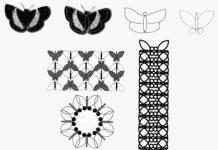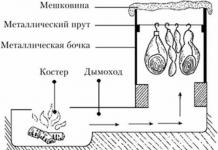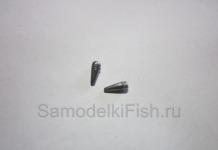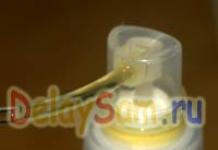Spathiphyllum is a plant with beautiful leaves and original colors. An unpretentious flower is popular among experienced and novice flower growers. If you are looking for a plant that will bloom almost all year round, then this is Spathiphyllum. Care at home for him is simple, does not require special skills. It is enough to familiarize yourself with the basic rules of cultivation.
Spathiphyllum, or Spathiphyllum (lat. Spathiphyllum) belongs to the Aroid family. The natural habitat is a tropical climate. Distributed in East Asia and America. About 40 species are known. As a houseplant, spathiphyllum is distinguished by a variety of varieties and colors. Evergreen herbaceous perennial, average height up to 30 cm. There are tall and dwarf varieties.
The plant does not have a stem, a bunch of leaves grows directly from the ground. The leaves are dark green, oblong-lanceolate. Spathifullum flowers look original - cobs on long peduncles of cream or pale pink color. The flower is surrounded by a white veil, gradually it becomes green. The shape of the veil is compared with a flag developing in the wind. For this, the people often call him a flagman. 

Inexperienced amateur flower growers are sometimes faced with a lack of flowering. They achieve it with enhanced care, compliance with all the rules of cultivation. Blooms from spring to mid-summer. Sometimes re-blooms in autumn.
Interesting! All types of spathiphyllum are popularly known as "women's happiness". It is believed that he expels loneliness from the house. It helps single girls to find a betrothed, family girls to establish relationships with their soulmate, childless girls to have children.
Varieties of spathiphyllum
At home, they try to grow the most unpretentious varieties of spathiphyllum. Many plant species that exist in nature are adapted for growing in apartments, improved by breeders. Here are some popular varieties.
- Spathiphyllum Wallis. Served as the basis for the creation of most modern varieties. The bush reaches 45 cm, the inflorescence is up to 10 cm. It is considered the most unpretentious of all existing species.


- Spathiphyllum Domino. It is distinguished by high decorativeness not only of flowers, but also of leaves. They are neat, oblong in shape, with a sharp tip. The name of the variety was due to the unusual color - randomly scattered light strokes and stripes on a dark green background. The advantage of the variety is long flowering.


- Spathiphyllum Chopin. A small bush no more than 40 cm tall. The leaves are neat, oblong, the veins are pronounced. The variety was bred by breeders. It has an unobtrusive but pleasant aroma.


- Spathiphyllum Sensation. Tall hybrid. With good care, it reaches one and a half meters in height. Inflorescences are large, expressive.


- Spathiphyllum Strauss. An interesting undersized variety no more than 30 cm in height. The leaves are elongated, leathery, dark green.


- Spathiphyllum profusely flowering. A popular variety with a long flowering period. The inflorescences are medium in size, the leaves are oval, darkening as they mature. Peduncle long.


Spathiphyllum Care
Organizing spathiphyllum care at home is simple. The plant is not pretentious to care, it is easy to put up with temporary inconveniences. But for active growth and friendly flowering, it is recommended to adhere to the basic rules.

Advice! The pot for spathiphyllum is chosen not very spacious. With an excess of space, the plant directs efforts to build foliage. Flowering becomes scarce or stops altogether.
Reproduction methods
Propagated by dividing the bush, seeds and apical cuttings. Sowing seeds is resorted to in rare cases - to grow a new variety. There is no need to apply cuttings. The plant produces many children.
When children appear, the bush is divided into several parts. They make sure that roots and a growing point remain on each. In the absence of roots, the young plant is planted in wet sand for rooting. Pots are used small - about 9 cm.
Important! Sometimes the plant does not bloom for a long time. Why does the spathiphyllum not bloom? Perhaps the plant is too young - flowers appear when they reach maturity. The first flowering begins when the root system completely fills the pot. In adult plants, the lack of flowering is associated with low temperature, insufficient moisture, and poor soil.
Diseases, pests and growing difficulties
The flower rarely gets sick, but it can be affected by pests. It is recommended to systematically inspect the flower to detect insects.
- The leaves turn yellow. The main reason is the lack of moisture in the soil and air. It is recommended to rinse the flower from time to time under a warm shower.
- The tips of the leaves dry. Low air humidity. Use additional artificial air humidification in all possible ways. Spraying does not always solve the problem.
- The leaves turn black. Possible reasons are a lack of phosphorus, nitrogen, or a violation of the irrigation regime. Apply fertilizer and monitor soil moisture.
Of the pests, aphids, scale insects, mealybugs, and spider mites are often found. All of them lead to the death of the plant. If insects are found, the plant is bathed under a warm shower, treated with insecticides.
This is an ideal plant for beginner gardeners. It successfully combines decorativeness, beautiful flowering and unpretentious care.
Indoor flora is designed to please the eye of the grower and others. Flowers can organically fit into any interior, bring joy to the owner and even become his talisman. A popular culture called "women's happiness" is a frequent guest of our apartments. This green pet blooms very interestingly, purifies the air and gives harmony to every woman. This article will tell you about spathiphyllum home care, reproduction, transplantation. You will learn about the main problems of growing this wonderful plant in order to avoid such mistakes, as well as the beliefs associated with an exotic flower.
Spathiphyllum flower: description, photo
Spathiphyllum belongs to the Aroid family. The Latin name of the genus Spatiphillum is derived from two words that characterize the flowering of exotic - "leaf" and "veil".
Evergreen tropical perennials are incredibly popular in cultivation. The genus includes 50 species of terrestrial inhabitants of the tropical rainforest. Some species take a different life form - epiphytes. They are fixed on taller tree representatives of the flora in order to receive a large portion of solar radiation.
The underground part of the plant is represented by a short rhizome. Spathiphyllum does not have a central stem; basal rosettes are formed directly from the substrate. Exotic leaves vary in shape, color and size. The edges of the leaf blades are solid, the shape is both oval and elongated-lanceolate. The central vein is clearly visible on the surface of the leaf. The base of the elongated petiole is provided with a stalk-enclosing sheath with developed conducting vessels.
The flower-bearing stem is either equal in length to the petioles, or slightly exceeds their height. Like other representatives of the Aroid family, the spathiphyllum inflorescence looks like an ear, surrounded by a snow-white veil. Flower growers often call the exotic flagolist because of the similarity of an elongated oval bedspread with a small flag. When flowering ends, this part of the flower does not fall off, but becomes a green hue.
The inflorescence-cob is sessile or located on a small stem. Tiny flowers of both sexes are collected on the cob, distinguish between the male and female phases of flowering. The seeds of the tropical guest are small, curved with a smooth surface. Seed material loses its germination capacity very quickly.
On a note! Getting seeds at home is very difficult. This will require two adults blooming at the same time.
homeland spathiphyllum
It is very difficult to single out the homeland of pot culture, since the range of various representatives of the genus is scattered. Greatest species diversity concentrated in the tropical zone of Central and South America. The wet forests of New Guinea and adjacent islands belong to the Old World and are also home to some exotic species.

Spathiphyllums prefer to settle on the moist, rich litter of tropical forests, especially near swamps and other bodies of water.
Spathiphyllum: types and varieties
The first mention of spathiphyllum refers to late XIX century. German botanist Gustav Wallis discovered the new kind plants during an expedition to South America. Samples were transferred to Europe, but for a long time did not arouse much interest among breeders. In the middle of the 20th century, exotic finally gained well-deserved fame and became widely used to obtain hybrid forms.
The popularity of pot culture is due to the wide variety of cultivars. Among the varieties there are tiny plants and real giants, having leaves of various shapes, sizes and even colors. But most of all, gardeners are attracted by the beautiful and long flowering of a green pet, accompanied by a very pleasant fragrance.
Know! With proper care, spathiphyllum blooms can be admired for several months. After a short break, he again throws out the snow-white flags.

Of the 50 species of the genus Spatiphillum, the following varieties are found in culture:
- Wallis;
- profusely flowering;
- nice;
- Alana;
- helicone-leaved;
- spoon-shaped;
- cannolist.
Spathiphyllum Wallis got its name in honor of the discoverer of the species - Gustav Wallis. It was this variety that laid the foundation for selection and served as the genetic material for creating a variety of hybrids that are so popular in indoor floriculture. The plant reaches a height of 20-35 cm. Elongated-lanceolate leaves about 20 cm long sit on long petioles. As the bush grows, the petiole takes on an arcuate shape, the leaf blades droop smoothly.
The culture is shade-tolerant and unpretentious, therefore it is most common among flower growers. Inflorescences do not differ in large dimensions. The cob reaches a length of 3-4 cm, and the snow-white or greenish flag is three times larger than the inflorescence. The color of the cob is white or light cream. As the false flower withers, the color of its components (cob and flag) becomes green. The culture is characterized by seasonal flowering, lasting from April to the end of summer.
Be carefull! The color of the spathiphyllum bract is limited to white and greenish. If the sellers offer you to buy a red flagolus, under its mask there is a relative of the exotic from the Aroid family - anthurium or "male happiness".
The profusely flowering variety also does not stand out in large dimensions. A compact lush bush does not exceed a height of 40 cm. The young leaves of the culture are light green, the old plates are more saturated tones.

The leaf surface is dense with a pronounced central vein. The leaf blades are attached with thin petioles, reach a length of 20 cm. The petiole is half the length of the leaf, and bends over time. Peduncles of a profusely flowering variety are one and a half times higher than a bush. A small cream cob is framed by a snow-white flag 6-8 cm long and 3-4 cm wide. With proper care, the plant blooms all year round.
Spathiphyllum pleasant from fellows differs in growth of 50-60 cm and large saturated green leaves. The plates are elongated-lanceolate in shape with an elongated crown attached with strong petioles 25-30 cm long. The leaves reach the same length, the surface is dotted with a pronounced network of veins. Tropical visitor native to South America is very shade-tolerant, blooms throughout the spring, sometimes re-blooming is observed. The white cob is surrounded by a greenish bract 15 cm long.
Know! On the windowsill, a pleasant subspecies is rare.
Alan's species belongs to medium-sized cultures, height 50 cm. Elongated-oval leaves have a rich green color, temptingly sheen with gloss. The venation is pronounced, the petioles are strong, do not bend, which gives the bush an upright habit. The flag is wide with a pointed top. On the reverse side of the bract, a thin green vein is visible.
The helicone-leaved variety is distinguished by large leaves of a dark green hue. The plates along the edge form beautiful waves, cast with gloss. The length of the pointed sheet reaches half a meter, the width is half as much. Petiole durable 70-80 cm Tropical guest comes from the rainforests of Brazil, unpretentious, shade-tolerant, suitable for growing in office space. By the end of flowering, the snow-white ears become almost black. Inflorescence height up to 10 cm, bract twice as long. The bedspread becomes green as it wilts.

The spoon-shaped spathiphyllum belongs to large individuals, its growth reaches a meter in height. Elongated-elliptical leaves 15 by 40 cm sit on strong long petioles, reaching 70 cm. The surface of the sheet is glossy, dark green with pronounced venation. An oval coverlet of a snow-white shade is twice as long as an ear. Over time, it becomes intense green.
It is interesting! The spoon-shaped variety was named for the concave shape of the bract, resembling a cutlery.
Cannoleaf species (pictured) - a native of the tropics of South America, a rare guest on the windowsill, but is of interest as a collection plant. Dense ovate leaves are bright green in color, outwardly similar to the canna garden perennial. The length of the leaves is 35-40 cm. The inflorescence is white or yellowish, exudes a pleasant fragrance, and is distinguished by the absence of tubercles. Bract with a length of 15-20 cm has a bilateral staining. The side facing the cob is white and the wrong side is green.

And now consider the most popular varieties of spathiphyllum. Almost all of them are based on the appearance of Wallis, but outwardly they are strikingly different from each other. The following plant hybrids are on sale:
- Sensation. Tall cultivar, bred by Dutch breeders. The growth of the bush is up to 1.5 m. Huge (80-90 by 30-40 cm) textured foliage of a dark green hue forms lush bushes. Peduncles of large size. Suitable for rooms with low lighting.
- Domino. A variegated hybrid with a height of 35-50 cm. It differs from the original Wallis species by the presence of spots and strokes on the green mass. Frequent guest in the apartments.
- Chopin. Decorative due to luxurious dark green foliage with distinct venation. During flowering exudes a delicate aroma. Height 25-35 cm, unpretentious.
- Sweet Silvio, Figaro, Pablo are large-sized representatives 70-100 cm high. The leaves sit on long petioles, drooping over time. Lush bushes bloom continuously even in low light conditions. Used as floor compositions.
- Kaichi. New Dutch selection. It is distinguished by blurry golden spots on the foliage. Plant growth 50-70 cm. Widely used to decorate paludariums.
- Quattro, Mozart, Kroshka and Mini are undersized dwarf exotic varieties, no more than 12-15 cm high. They differ from the original only in size.
- Picasso. Variegated hybrid, distinguished by sectoral staining of deciduous mass. Sometimes white stripes and spots occupy the surface of the plate by more than 70% or completely. Not as widespread as its predecessor, Domino. Very picky about growing conditions.
- Mauna Loa. A hybrid of the selection of American specialists, bred on the basis of a profusely flowering variety. Wide pointed leaves sit on a ten-centimeter petiole. The height of the bush is 50 cm, the height of the cob is 5 cm, the flag is oval, concave, the flowering is long.

Important! Due to the long (25-30 cm) peduncles, the Mauna Loa cultivar can be used for cutting. Charming flowers will keep fresh for a month.
Spathiphyllum at home
The evergreen inhabitant of the tropics feels great in captivity. To achieve long flowering, he will need careful, but uncomplicated care.
Location and lighting
Wild-growing flagolists are not particularly demanding on light. Under the dense canopy of trees, not much sunlight breaks through to them. At home, you can keep a flower on the western or eastern window, since the lighting on the south side is too intense, and on the north side it is not enough. If there is no particular choice, shade with exotic tulle or install an additional light source - a diode lamp, a phytolamp.
An exception to the rule are variegated hybrids. Variegated cultivars are more demanding on the presence of the sun at home, because their leaves are deprived of part of the chlorophyll pigment. Even variegated varieties should be protected from the scorching midday sun.
Not bad exotic guest feels in the summer on a glazed balcony or loggia. Pull the tulle a little, creating an openwork penumbra, and do not abuse the airing, because the flower does not tolerate drafts.

Attention! Watch the appearance of female happiness, if the leaves begin to stretch and shrink, move it to a brighter part of the room.
Feeding and watering
Representatives of the Aroid family are very moisture-loving. They need plentiful and frequent watering, but it is not worth pouring the flower too much, because of this the tender roots will certainly rot. Irrigation is carried out as needed, when the top layer of the substrate dries out a little. Complete drying of the earthen coma should not be allowed. In winter, watering is carried out less frequently, since there is a high risk of development of putrefactive processes in the root zone due to the cool environment on the windowsill. Women's happiness will independently tell you about the lack of moisture, sadly hanging the leaves. Water for irrigation should stand for at least 12 hours.
Other water procedures - spraying, sprinkling - will also have a beneficial effect on the health of a home flower. Sprinkling twice a month will help the flagolist look healthy and get rid of dust. Place the pot in the shower or bath and pour warm water from the shower head. If the purpose of such an event is only to get rid of the dust accumulated on the foliage, be sure to cover the soil surface with polyethylene.
Top dressing is applied from spring to the end of September to stimulate the laying of flower buds. During the dormant period, there is no need for fertilizers. The intake of nutrients during hibernation provokes the extension of the bush. As a top dressing, it is convenient to use ready-made fertilizers for flowering houseplants or Aroids. The dosage depends on the age of the individual - the young are given half the portion of the fertilizer, the adult specimens are given the full portion. If your spathiphyllum does not hibernate, that is, it is kept under artificial lighting all year round, it needs to be fed once a month in winter and late autumn.
Advice! It is permissible to use a weak infusion of mullein or nettle as a fertilizer. Young individuals need nitrogen to build up green mass, while adults need to significantly reduce the amount of this trace element so as not to slow down flowering.
pruning
Air humidity and temperature
The tropical inhabitant is accustomed to growing in a warm, humid climate, so at home he needs to recreate the conditions of his natural habitat. Maintain a temperature background of 21-23⁰C in summer and spring, and by winter, if necessary, lower the temperature to 16-18⁰C. A decrease in the temperature background to 10-12⁰C threatens the exotic with death! Flagolist roots should be kept warm. Place a circle of foam or other insulation under the flower pot. And be sure to protect the bushes from drafts.

For women's happiness, for a comfortable existence in captivity, it is important to observe one more condition - high humidity. Daily spraying will help to fill the moisture deficit, in the summer you can perform the procedure several times a day. It is useful to install small containers of water next to the flower or put the pot in a tray with wet pebbles, moss. Periodically top up the evaporating liquid.
On a note! In winter, it is especially difficult to maintain the necessary air humidity, because the heat from the batteries dries it out very quickly. A modern household appliance will come to the rescue - an air humidifier.
soil for spathiphyllum
The natural habitat of the flagolist provides for growth on a light, moisture-absorbing, organic-rich rainforest litter. The substrate consists of rotting foliage and twigs, vegetable compost. At home, you can recreate such a soil mixture using a ready-made substrate for Aroids. You can take the soil for orchids and add peat, perlite, garden soil to it. The ratio of components is 3:3:2:2.
The second option for a self-prepared substrate is to mix equal parts of turf, peat, leafy soil, coarse sand or perlite. Chopped bark of coniferous trees, fine expanded clay or brick chips and charcoal are added to the composition. To increase the moisture capacity, you can add a little crushed sphagnum to the soil.
Spathiphyllum reproduction
Women's happiness can be reproduced by seeds and vegetative methods - dividing the bush, baby cuttings. Consider the nuances of each method of propagation of the flagolist.
Seed propagation gives flower growers a lot of trouble. The disadvantage of this method is the need for artificial pollination, poor seed germination and rare transmission of varietal traits to offspring. In addition, tiny seedlings develop very slowly, becoming adults only after 4-5 years.
Remember! The seed material has a low germination rate (no more than 50%), which decreases even more over time, leaving virtually no chance of germination.
The combination of such breeding difficulties will not frighten unless an experienced grower, so beginners do not even think about taking on sowing seeds. It is almost impossible to obtain seed at home, so it is better to purchase seeds in the store and immediately start sowing.
Basic rules for growing seedlings:
- sowing seeds is carried out immediately after purchase or collection;
- make sure that the seed bag has a fresh date of collection;
- seed is sown in a mini-greenhouse filled with a mixture of peat and sand or vermiculite;
- maintain high humidity in the greenhouse by spraying the soil;
- temperature background 23-25⁰C. Be sure to illuminate the seedlings;
- periodically ventilate the abode of seedlings, wipe the condensate;
- after the appearance of two leaves, plant the seedlings in an individual container of a small volume;
- as you grow, periodically change the pots, slightly increasing the feeding area;
- top dressing in half concentration 2 times a month.
Vegetatively propagating a female flower is very simple. It is convenient to coincide with the event for the annual transplant. Take out a well-watered bush and divide it into several parts with a well-developed root system and aerial part. Such individuals are immediately considered adults, they are cared for as usual. To facilitate rooting for a while, cover the planted layers with a jar. It is not necessary to feed transplanted layers for another 2-3 months.

Small children with weak roots or without them at all can be rooted to obtain new individuals of the flagolist. You can root them in the substrate used for sowing seeds, pure perlite or water. V last case a crushed tablet is placed in a glass of water activated carbon to prevent rotting. When the roots appear, transplant the kids into small pots.
Attention! Leaf cuttings for culture propagation are not used. Even a stalk with a heel is not suitable for these purposes.
Conditions required for flowering
Novice flower growers are often faced with the fact that the spathiphyllum stubbornly refuses to bloom or gives only a couple of flower stalks per season. The reason for this may be insufficient care and an incorrectly selected pot.
A young individual under the age of three years will not bloom, usually the first flowering occurs at 3-4 years of age. The size of the pot plays a big role for an exotic guest. The more spacious the container, the longer you have to wait for the appearance of flower stalks. This is due to the fact that the plant first masters the provided soil conditions. Until the roots are completely entwined with an earthen lump, it is pointless to wait for flowers. When transplanting a bush, pick up a tighter pot. And be sure to make drain holes in the bottom so that the earth does not acidify from waterlogging.
The temperature background and humidity play a big role in the formation of flower buds. If you do not follow the recommendations described above, the likelihood of white flags is extremely small. Another reason for the prolonged absence of buds is an excess of nitrogen in the substrate. At the same time, the flower fattens, abundantly increasing the leaf cover and daughter rosettes.

Remember! For flowering specimens of indoor flora, it is not nitrogen that is important, but potassium and phosphorus. These trace elements should prevail in the selected mineral supplement.
Transplanting into a cramped pot and resting for 3 weeks in cool conditions (artificial winter) will help stimulate the flowering of female happiness. Remember to reduce irrigation and do not fertilize. This method activates flower buds. The faded spathiphyllum will also need rest, so that before the formation of a new batch of buds, it has time to gain strength.
Spathiphyllum transplant
Flagolists are prone to rapid growth, so young individuals require annual transfer to a large container. More mature specimens over five years old are transplanted only after mastering the earthy coma, when roots begin to show through the holes at the bottom of the pot. When growing large specimens, annual replacement of the top layer of the substrate is acceptable.
The transfer is carried out as follows:
- water the plant being prepared for transplanting abundantly;
- take the pot with a diameter of 2 cm more than the previous container;
- but fill the containers with a 3 cm drainage layer of expanded clay, pebbles;
- pour a layer of soil over the drainage layer of such a height that the growth point of the bush is at the same level. Deepening is unacceptable;
- remove the exotic from the pot and separate the layers. This stimulates growth, will help grow a lush bush;
- transfer the flagolist together with an earthen clod into a new container;
- fill empty spaces with fresh soil, compact a little and water.

After transplantation, it is not necessary to water female happiness for 3-4 days, but the leaves should be sprayed every day. This video demonstrates flower transplantation in detail.
Get armed! To recover more quickly from the stress caused by the transplant, adding a growth stimulator to the spraying water - Epin, potassium humate, will help.
Common Growing Problems
One of the most common problems of growing an exotic guest is improper maintenance - violation of the rules of watering and temperature control.
The most alarming signal is the appearance of blackness or brown spots on the foliage. It indicates that you flooded the poor fellow and the roots of the flower began to rot. This results in a combination of low temperature and high humidity. Take action to save your pet!
An emergency transplant will help a representative of the Aroid family recover from the disease, during which all rotting roots must be removed. Use a sterile instrument, and after the “operation”, disinfect the root lobe in a solution of potassium permanganate, sprinkle the sections with crushed coal. Clean the aerial part of the flag leaf from damaged tissues, treat with a fungicide solution.

If blackness appears on the tips of the foliage, the pet is experiencing a nutritional imbalance. Such a reaction is typical with an excess or lack of trace elements. Adjust the feeding mode.
Why spathiphyllum does not grow reasons
The reason for the inhibited development of the culture may be a lack of nutrition. This is especially true for young specimens that need in large numbers nitrogen. Severe light deficiency also inhibits growth.
The lack of visible development is observed when the flowerpot is too large. While the above-ground part practically does not give growth, a powerful root system grows underground.
On a note! The flagolist will begin to grow after weaving the roots of all the provided soil.
Spathiphyllum: dry, yellow leaves and their tips causes and their elimination
Drying of the tips of the leaves or yellowing of the plates is most often the result of missed watering or insufficient air humidity. Eliminate the flaws of agricultural technology, and the pet will regain its decorative look.
The appearance of yellowness in the crown happens due to nutritional deficiencies, so do not forget to feed your green pet. If you do not follow the rules of cultivation, be prepared for the attack of pests, they also cause yellowing of the foliage.
Spathiphyllum diseases and pests
Diseases of an evergreen tropical inhabitant arise as a result of improper care. Phytosporosis and root rot affects the roots, leading to decay. Manifested by brown spots and the oppressed state of the pet. Immediately transplant with the removal of the affected roots.
Among the pests on the spathiphyllum can settle:
- spider mite;
- thrips;
- mealybug;
- scab;
Advice! Sprinkling 2-3 times a month is considered an excellent prevention of the appearance of pests.
Spathiphyllum - signs
Women's happiness is an unusual flower. Own beautiful name he received it thanks to the goddess of love, who gave the flagman a part of the happiness experienced on the wedding day. According to legend, Astarte endowed the flower with the ability to give her mistress harmony in relationships.

There is a sign that a donated flower will help you find a worthy husband, create a strong family. They say that female happiness helps to have a baby, especially if you get a layer from a family where a baby has recently appeared. Spathiphyllum helps to strengthen family ties, achieve complete harmony in relationships, relieves jealousy and negativity in relationships. Anthurium will make an excellent company for female happiness, but you don’t need to plant them in one pot, as some advise. Two exotics from the same family have different substrate requirements.
In addition to the sacred meaning, a green pet is extremely beneficial for the environment. It absorbs harmful compounds like formaldehyde, xylene, carbon dioxide and converts it into food. Green growth on the window saturates the air with oxygen, releases phytoncides that can destroy pathogenic microflora.
Important! The juice of an indoor dweller is poisonous. Protect your hands with gloves during transplanting and keep the lush bush away from children. Animals are rarely interested in such weed, because it tastes very bitter.
Spathiphyllum home: secrets of success or useful tips
What is the secret to successfully growing indoor exotic? Experienced flower growers claim that in maintaining proper care. If you recreate conditions close to natural and properly care for the flagolus, he will feel great.
A few rules and useful tips, will help to achieve the health of a tropical guest:
- You need to plant the flagolist in a tight pot, the volume of which is slightly larger than the previous one.
- Insufficient watering and waterlogging of the substrate can lead to death.
- The juice of the culture is poisonous and causes contact dermatitis. Protect skin from droplets.
- Maintain high humidity.
- The course of the disease, the appearance of pests or non-compliance with the rules for growing spathiphyllum signals changes in appearance.
- To stimulate flowering, arrange an artificial winter for indoor exotics.
Conclusion
Spathiphyllum care at home is simple. An unpretentious guest from the tropics will delight you with beautiful flowering, high decorativeness. Do not forget to follow the recommendations described in the article, then the flagolist will surely bring the desired female happiness.
Video: spathiphyllum transplant rules for abundant flowering
Spathiphyllum is a flowering plant, a member of the Aroid family. Its homeland is the Philippine Islands, Indonesia, tropical regions of Central and South America.
The name Spathiphyllum has Greek roots: "spatha" - "cover" and "phyllum" - "leaf". Indeed, the flower of the plant has a rather unusual structure, characteristic of most Aroids: a yellow "cob" covered on one side with a coverlet. The exotic appearance gave rise to the "folk" names "White Sail" and, more common among Russian flower growers Spathiphyllum, "Women's Happiness".
Spathiphyllum is characterized by a shortened rhizome. Leaves on long petioles, oval or lanceolate, collected in a dense basal rosette. Leaf blades are rich green, although there are species with a pale green color and varieties with variegated foliage. Leaf margins are entire, smooth or slightly wavy. Another decorative touch is the central and lateral veins. Convex or depressed, they are clearly visible on the surface of the sheet. The cuttings are expanded at the bottom. The peduncle with a flower rises a few centimeters above the foliage. "Sail" is a bract. It is painted white on the inside and greenish on the outside. The flower itself is a cylindrical inflorescence.
Photos representing the most popular types of plants and indoor flower varieties - spathiphyllum
In various sources, the number of species of this plant ranges from 36 to 45, but only a few of them are suitable for growing in room culture.








A plant up to 60 cm high with dark green glossy leaves. The wavy edges of the leaf plates give the plant an additional decorative effect. The length of the cutting is about 25 cm, the leaf is approximately equal to the cutting. Peduncles slightly rise above the green mass. The inflorescence is pale yellow, the veil is white, but at the end of flowering it acquires a greenish tint. The size of the bedspread is three times larger than the inflorescence.

Species - Spathiphyllum Wallis
The flowering period is May-June. With abundant watering and a normal level of air humidity, it is possible to repeat the flowering period in autumn or winter.
Based on the species, several popular varieties of small and medium sizes have been developed. compact varieties include Mozart (Mozart), Macho (Macho), Numero Uno (Numero Uno). The last two varieties are especially attractive due to the strongly elongated leaves and bedspreads with a long pointed tip.
Medium-sized varieties include Claudius (Claudius), Chopin (Chopin), Sweet Silvio (Svit Silvio). Up to 50 cm high, these plants are characterized by the ability to almost continuously bloom and are suitable for decorating medium-sized rooms.
Large varieties include Spathiphyllum Sensation (Sensation). The plant reaches one and a half meters in height, due to which it is ideal for growing in spacious rooms - halls and offices. Large leaves reach 50 cm wide and 100 cm long. Leathery, glossy, due to the pattern of veins, they are slightly similar to the feathers of an exotic bird.
Separately, it is worth highlighting the variegated form, Spathiphyllum Domino (Domino). The leaves of the plant are mottled with spots and strokes of pale green or pale yellow, which adds additional decorative effect. However, variegation (variegated color) is possible only in conditions of abundant diffused light. In partial shade, the foliage will “lose” spotting and acquire the usual green color.

This variety blooms almost all year round.
Srednerosly look with oval oblong leaves of saturated emerald color. Spathiphyllum profusely flowering reaches a height of 50 cm. The name of the species speaks for itself: the plant really gives abundant flowering, which lasts about a month.
The most popular Spathiphyllum profusely flowering variety Mauna Loa (Mauna Loa). Light green leaves have an elongated elliptical shape. The ends are pointed. Peduncles are a third higher than the height of the foliage. Inflorescence cream, up to 3.5 cm long. The bedspread is snow-white, about 12.5 cm in size. The variety is famous for its almost year-round flowering.
Spathiphyllum heliconiaceae
Its glossy leaves are deep green. The edge of the leaf blade is slightly wavy. The petiole is long, up to 90 cm. The inflorescence, unlike other species, is white, up to 10 cm long. The spathe is oval, white, reaches 15 cm in length and 10 cm in width. At the end of flowering, the color of the inflorescence gradually darkens until the "cob" turns black.
How to properly care for a spathiphyllum indoor flower at home

Spathiphyllum loves a loose and air- and moisture-permeable substrate
Caring for Spathiphyllum at home is not difficult. The plant adapts easily and does not require increased attention, but there are still a few basic rules.

1. Set the plant pot on a tray of wet pebbles or sphagnum (the drainage holes of the pot must not come into contact with water).
2. Place a humidifier or a small container of water next to the pot.

Spathiphyllum must be sprayed every day
3. Spray the plant daily. Water should be at room temperature, soft. Flowers and buds can become covered with black dots from splashes, so they must be protected from moisture before spraying. For these purposes, the usual plastic bag. It is carefully put on over the flowers and held.

How to propagate a spathiphyllum houseplant
The easiest way is to propagate Spathiphyllum during transplantation by dividing the bush. To do this, the rhizome is shaken off the ground and divided with a knife or scissors so that each individual part has a growth point and two or three leaves. Young plants are planted in moistened soil suitable for Spathiphyllum and are not watered for the first days, limited only by spraying.
It is also possible to propagate by cuttings. It is carried out during the period of active growth. Cut cuttings are rooted in a greenhouse with an air temperature of + 25ºС in a peat-sand mixture.
Possible problems when growing spathiphyllum

In the photo, a spathiphyllum that lacks moisture
Failure to comply with the regimes of illumination, feeding and watering can lead to the appearance of alarming symptoms and a general weakening of the plant. The most common problems are:
1. Spathiphyllum does not bloom. This may be caused by:
- lack of light;
- too large pot size;
- lack of a dormant period;
- lack of minerals in the soil.
2. . Leaf blades lose turgor, droop. The reason is the lack of moisture in the soil and air.
3. The plant has got brown spots on leaf blades. Cause: sunburn or rotting due to stagnant water in the soil.
4. At Spathiphyllum, the tips of the leaves turn black and dry.. Causes:
- lack of fertilizers;
- too abundant and frequent watering;
- insufficient air humidity.
Plants weakened by improper care can be attacked by insect pests - thrips, scale insects, aphids. You can get rid of them with the help of systemic insecticides (Aktara, Aktelik, etc.)
Signs associated with spathiphyllum

It is believed that the flower brings women love and prosperity.
Spathiphyllum got its name "Women's Happiness" not in vain. If you look closely at the plant at the beginning of the flowering period, it becomes noticeable that the birth of a new flower is very similar to the birth of a new human life. One of the petioles begins to stand out among the brethren, gradually “gets fat”, a thickening appears - the “tummy”, which is getting bigger and bigger. Time passes, and through a thin cover you can already see a white "diaper". A few days and through the longitudinal crack begins to look through the tip of the bedspread. The peduncle begins to grow rapidly, finally the veil opens, revealing the inflorescence.
It is believed that the plant acquires special power during the flowering period and brings the energy of love and prosperity to its women's mistresses. A lonely woman soon becomes loved; childless finally become mothers. Married women Spathiphyllum gives harmony and happiness in relationships with her husband.
Spathiphyllum (Spathiphyllum) is a herbaceous perennial from the Aroid family. Spathiphyllum is native to the tropical regions of Central and South America. Some species originate from Indonesia and the Philippine Islands.
The plant is decorative due to the glossy dark emerald foliage, collected in a basal rosette from 30 cm to 1 m high. The rhizome of the flower is shortened, the stem is absent. The leaves are oval, pointed towards the apex, with a distinct midrib. Petioles are long, expanding downwards.
The plant is very similar to, read how they differ.
The inflorescence is an ear wrapped in a delicate snow-white veil in most species, although there is also a light green shade. After the end of flowering, which lasts 6-10 weeks, the cover turns green.
| In one season, the plant doubles in growth. | |
| It blooms in summer, with high humidity it can bloom in winter | |
| The plant is easy to grow in room conditions | |

| Perennial |
The flower is known as one of the best air purifiers from various harmful chemical compounds- benzene, formaldehyde, trichlorethylene and others, as well as from acetone and alcohol vapors. According to some sources, it counteracts the appearance of mold.
However, like most aroids, it contains oxalate crystals that can cause irritation of the oral mucosa, tongue, and even swelling of the larynx, if suddenly little child I would like to taste the leaf of the plant.
Signs and superstitions
 Among flower growers, a conflicting opinion is transmitted about the energy of a perennial - some believe that he expels men from home, others, on the contrary, are sure that he helps to find his soul mate. After all, it is not for nothing that the flower is called “female happiness”.
Among flower growers, a conflicting opinion is transmitted about the energy of a perennial - some believe that he expels men from home, others, on the contrary, are sure that he helps to find his soul mate. After all, it is not for nothing that the flower is called “female happiness”.
They say that if you grow it next to anthurium - "male happiness", then harmony and mutual understanding will reign in the house. It’s even better to plant them in one pot, however, many flower growers are skeptical about such a sign - plants have significantly different conditions for care and maintenance.
One of the most important superstitions associated with the flower indicates the attraction of love and the onset of a long-awaited pregnancy. And the expected event will happen as soon as the spathiphyllum bud blooms.
If the flower dries up, then happiness leaves the family. The plant does not tolerate scandals and quarrels in the room, immediately lowers the lifeless leaves. Whether these signs are true or not, each grower decides for himself.
Features of home care (Briefly)
| Temperature | In summer, it grows at 18-27 degrees, in winter it is desirable to observe 16-18 degrees of heat, with a short-term absence of watering, the critical indicator is 13 degrees above zero. |
| Air humidity | At least 50% is required, spraying is required in summer. |
| Lighting | The light is dim, adapts to partial shade, gets burns from direct sunlight. In winter, good diffused lighting is important. |
| Watering | The earth ball should be kept constantly moist. In summer, water 2-3 times, in winter - 1 time per week. |
| Priming | The soil mixture is made up of 2 parts of soddy land and 1 part of leaf, peat, humus soil and sand taken with the addition of a small amount of brick chips and charcoal. A layer of expanded clay drainage is required at the bottom. |
| top dressing | Spathiphyllum at home is fed once a week with universal fertilizer from spring to autumn, in winter - once every 2-3 weeks. |
| Transfer | Annually in the spring with moving to a flower container of a larger diameter, mature plants - after 3-5 years. |
| Growing features | He does not like being placed in a draft or near a gas stove. |
Novice flower growers gladly replenish their home collections with a plant, since it does not make special high demands on its content.
 With proper care, spathiphyllum is characterized by long flowering - from one and a half to 2.5 months, and this is its main advantage. Miniature flowers are collected in an inflorescence-cob - both male and female on one. Seeds are not set at home, because their formation requires pollination by a special kind of bees.
With proper care, spathiphyllum is characterized by long flowering - from one and a half to 2.5 months, and this is its main advantage. Miniature flowers are collected in an inflorescence-cob - both male and female on one. Seeds are not set at home, because their formation requires pollination by a special kind of bees.
The size of the cob is different depending on the type and variety of spathiphyllum, but the color is almost always snow-white, occasionally light green. That is why the plant is often called "white sail" by the people, although "female happiness" is a more common name.
According to legend, the goddess of love Astarte breathed a small fraction of her happiness into the flower on her wedding day so that he would give them to all girls of marriageable age. The botanical name of the plant is also associated with its inflorescence and is translated from ancient Greek as a veil-leaf.
After the spathiphyllum has faded, you should cut off the arrow at the very base
Temperature regime
Spathiphyllums are heat-loving plants and develop normally only when the temperature in the room is maintained in the range from +18 to +25 degrees above zero. Heat is tolerated only if there is a sufficient increase in air humidity, but the critical mark for them is no more than 32 degrees. In winter, it is undesirable to allow the thermometer to drop below 15 degrees Celsius. The flower does not like drafts and cold, which blows from an open window.
spraying
Humidity is an important condition in the cultivation of spathiphyllum. The plant favorably perceives spraying, especially in the summer heat..
However, the plant is able to adapt to dry air with a constant humidity level of no more than 40-50%.
Lighting
Experts argue about the plant's requirements for light: some consider it shade-tolerant, others, on the contrary, prefer bright but diffused lighting. Direct sunlight damages glossy foliage, leaving burn spots. The lack of lighting affects the unevenness or lack of flowering.
Placement on the windowsills of the east or west direction, shaded during the hours of the active sun, will be optimal for the flower, however, even under artificial lighting, the plant develops quite normally.
Watering
 Spathiphyllum requires a constantly moist, but not wet state of an earthy coma. The plant instantly reacts to the lack of moisture in the soil by lowering the leaves, however, the turgor is quickly restored immediately after watering.
Spathiphyllum requires a constantly moist, but not wet state of an earthy coma. The plant instantly reacts to the lack of moisture in the soil by lowering the leaves, however, the turgor is quickly restored immediately after watering.
The flower does not tolerate the overdrying of the soil mixture, part of the root system dies off, and the leaves that seem to have restored elasticity often turn yellow and dry out anyway. Moisturize the spathiphyllum 2-3 times a week during the summer heat with soft settled water. In winter, watering is reduced to once a week. However, they try to prevent stagnation of water in the pan and drain the excess liquid.
Soil for spathiphyllum
The plant is grown in a loose fertile substrate, consisting of equal parts:
- humus,
- peat soil,
- leafy soil and sand plus twice the sod land.
Everything is thoroughly mixed and a few small pieces of brick chips and charcoal are added. A layer of expanded clay or pebble drainage is laid at the bottom of the flower container.
Top dressing and fertilizer
The plant needs constant feeding both in summer and in winter period, if it continues the growing season, and does not rest. From April to September, the spathiphyllum flower at room conditions is fertilized every 15-20 days with complex mineral fertilizers with the same content of potassium, phosphorus and nitrogen. In winter, top dressing is reduced to once a month and universal fertilizers with a reduced dose of nitrogen are chosen.
 Young specimens of spathiphyllum need an annual transplant.
Young specimens of spathiphyllum need an annual transplant.
More mature plants are allowed to be transplanted into a more spacious flower container less often - once every 3-5 years. However, for each plant, a decision must be made in individually- rapidly growing bushes with a large number of child lateral pagons may be cramped in a pot, and they will refuse to bloom.
When transplanting, you should not immediately choose a pot that is much larger than the previous one. The roots will take a long time to master the interior of the vessel to the detriment of the expected flowering.
pruning
Home spathiphyllum does not need regular pruning activities.. It is important to remove faded cobs in a timely manner to initiate re-blooming, as well as cut off yellowed leaves at the very base.
Reproduction of spathiphyllum
At home, the plant reproduces only in the process of transplantation by dividing the rhizome into several parts. It is important that each division consists of healthy roots and a young rosette of leaves. Sometimes it is not possible to separate the shoot with roots from the mother plant. In this case, it should first be rooted in water, and then planted in the soil mixture for growing adult spathiphyllums.
It is also possible to propagate the plant by seeds, but planting material is not easy to find in a flower shop, and this method is more laborious and time consuming.
Diseases and pests
Among the pests on the spathiphyllum, many insects have been seen - aphids, scale insects, thrips, mealybugs and whiteflies, but spider mites are especially annoying to the perennial.
Types of home spathiphyllum with photos and names
V indoor cultivation the most popular are several types of spathiphyllum out of 50 known in nature:

A plant with a dense rosette, sometimes consisting of 40 leaves, glossy and dark emerald, 20-25 cm long. It can bloom all year round, the inflorescence is white-yellow.

The foliage of this species resembles canna leaf blades and reaches half a meter in height. The cob of light green-yellow color is covered with a delicate white-greenish veil. It blooms with good care twice a year: in April-June and at the end of November.

It is distinguished by a pale green veil covering the ear of the same shade, surrounded by large foliage up to 20-35 cm long on petioles reaching 30-40 cm.

A tall species that can stretch up to a meter mark. The leaves are large, about 35-40 cm, on petioles 70 cm high. Feature inflorescences - yellowish at the beginning of flowering, by its end it almost turns black. The bedspread is white and has a concave shape similar to a sail.

Perennial with a height of 30 to 60 cm with shiny foliage up to 25 cm long. The edges of the leaf blades are wavy. Flowering begins in late spring or early summer, again - in autumn or winter. The cob is light yellow, wrapped in a snow-white veil, three times larger than the cob.
The best varieties:
Chopin - compact variety no more than 30-35 cm tall with fragrant flowers with an elongated veil with a pointed top;
sensation - considered the largest variety in indoor cultivation, reaching 150 cm in height, with foliage almost 80 cm long;
Picasso - variegated variety with a white-green pattern on the leaves;
Cupido - Dutch hybrid with an unusual shape of the bedspread - elongated and narrowed to the top, painted in various shades of green.
Spathiphyllum is very popular in indoor floriculture due to its unpretentiousness and easy care, accessible even to beginners who master the basics of handling plants.
Spathiphyllum (Spathiphyllum) - popular perennial aroid family. The name comes from two Greek words: "spatha" - coverlet and "phyllum" - leaf, characterizing the specific shape of the flower, which resembles an ordinary leaf of a plant, but only white.
Homeland spathiphyllum - South America, East Asia, Polynesia. The plant has no stem, basal leaves form a bunch directly from the soil. The root system of the flower is quite short. The leaves are oval with a well-defined midrib. The lateral veins on the leaves are depressed from the upper side.
Inflorescence in the form of an ear: on a long stem, with a veil at the base. The white cover after the end of flowering quickly turns green.

If after the acquisition the spathiphyllum is in a technical pot, then after two or three weeks it should be transplanted into a pot that will be slightly larger. This flower differs from the vast majority of other indoor plants in its moisture-loving nature, so after buying it, check that the ground is sufficiently moist. Otherwise, water it immediately.
It is best to put a flower closer to the window, which is located on the north side of the house. This location will ensure optimal sunlight supply, while at the same time eliminating the possibility of overheating. It should be remembered that spathiphyllum is categorically contraindicated in rooms with dry air. In winter, you can spray this plant a little less than in summer, but you still need to do it.
A flower called "spathiphyllum" is a big favorite among florists and flower growers. This indoor flower, which is not picky about lighting. Spathiphyllum can be a great decoration for an office space and other rooms that do not have good lighting. Experienced botanists will say that caring for this flower is similar to caring for it, but there are still certain differences.

Location and lighting
To lighting, as mentioned above, the spathiphyllum is not picky at all. The flower feels great in partial shade and even in the shade. Although if you constantly keep it in a poorly lit room, its leaves will become smaller, so do not overdo it with the lack of lighting. Bright light will also not harm the plant. Rather, on the contrary, it will be useful.
The best place for growing spathiphyllum is the northern windows. If the plant is located on the south side, it is important to shade it from direct sunlight. It is important to protect the plant from drafts.
Temperature
As for the temperature suitable for spathiphyllum, there is nothing new here: room temperature of 22-23 degrees is perfect. The plant will bloom at a temperature of 18 degrees, and sometimes 16 degrees will be enough. The main thing is that it should not be lower.
Air humidity

If you look at all aspects of spathiphyllum care, then the most important thing is, perhaps, maintaining a certain humidity in the room. Spathiphyllum loves high humidity. In the warm season - in summer and spring, spray the flower at least twice a day. If you do not have enough time to spray the plant, you can put it in a container filled with wet expanded clay. This method allows you to maintain constant humidity, especially in hot weather.
Watering
Spathiphyllum should be watered all year round. During flowering, in spring and summer, spathiphyllum needs abundant watering, watering should be moderate in winter. Water for watering the plant should be settled, its temperature should fluctuate in the range from 18 to 23 degrees. Water in a pot with spathiphyllum should not stagnate, therefore, excess water, if it forms, should certainly be drained.
The soil

The optimal composition of the soil for growing spathiphyllum: turf, leafy, peat, humus soil and sand in a ratio of 2:1:1:1:1. If it is possible to add sphagnum moss - do it, it will protect the soil from drying out.
Top dressings and fertilizers
Spathiphyllum must be constantly fed. Otherwise, this houseplant will not bloom, and if it does, it will not be long and irregular. From spring to autumn, when the plant has active development, it should be fed once every two weeks. In other cases, once a month will be enough. Great as a top dressing organic fertilizers, such as for example a solution of bird droppings. If it is not possible to purchase them, then universal fertilizers or fertilizers for flowering plants are quite suitable.
Transfer
Spathiphyllum will thrive if repotted once a year in the spring. In this it resembles a plant. When transplanting, you need to follow a certain technique. It is also worth taking into account that each time the pot should be slightly larger than the previous one.

Spathiphyllum reproduces mainly by dividing the bush, less often by seeds. Reproduction by dividing the bush can be carried out during the transplantation of the spathiphyllum. To do this, the roots of the plant must be freed from lumps of earth, and divided with a knife or scissors, so that each bush has a growth point and 2-3 leaves.
Young plants should be planted in small pots with moist soil. In the early days, spathiphyllum seedlings should not be watered; regular spraying will be enough. If you follow all the tips written here, then the spathiphyllum will begin to bloom in about 8 months.
Diseases and pests
Spathiphyllum is most often attacked by thrips and mealybugs.

There is another option that the flower does not have enough top dressing. If you are sure that everything is in order with temperature, and with humidity, and with top dressing, then, most likely, the spathiphyllum is simply old and flowering is a lot of work for it.
If, then here you can almost say with absolute certainty that the problem is in watering. You either give too little moisture to your flower, or vice versa - pour the liquid. Also possible reason may be due to a lack of nitrogen or phosphorus.
Another sign that you are not giving your spathiphyllum enough moisture is yellowing leaves. You can try to arrange a flower bathing once a week in water at a temperature of about twenty degrees. Such "baths" are an excellent prevention of the appearance of all kinds of pests.



































